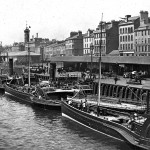 Named after the Brumelaw Croft, a stretch of land running along the north bank of the Clyde, the street known as the Broomielaw extends from Jamaica Bridge to Finnieston Quay. It was Glasgow merchant Walter Gibson, “the father of the trade of all the west coasts”, who financed the building of Glasgow’s first quay, at the Broomielaw in 1688. Significant progress in bringing shipping into the heart of Glasgow would have to wait until the Clyde was made more navigable and major obstacles such as the sandbank at Dumbuck cleared. By 1775, the channel from the Broomielaw to Dumbuck was almost 8 feet deep depending upon the tide. Europe’s first commercial steamer service in the form of Henry Bell’s “Comet” departed from the Broomielaw in 1812. It was the Scottish civil engineer, Thomas Telford who redesigned the Broomielaw quays to handle the busy steamboat traffic as thousands of immigrants came over from Ireland in the mid 19th Century to work in the new industries generated by the Industrial Revolution. Glasgow was becoming an industrial powerhouse.
Named after the Brumelaw Croft, a stretch of land running along the north bank of the Clyde, the street known as the Broomielaw extends from Jamaica Bridge to Finnieston Quay. It was Glasgow merchant Walter Gibson, “the father of the trade of all the west coasts”, who financed the building of Glasgow’s first quay, at the Broomielaw in 1688. Significant progress in bringing shipping into the heart of Glasgow would have to wait until the Clyde was made more navigable and major obstacles such as the sandbank at Dumbuck cleared. By 1775, the channel from the Broomielaw to Dumbuck was almost 8 feet deep depending upon the tide. Europe’s first commercial steamer service in the form of Henry Bell’s “Comet” departed from the Broomielaw in 1812. It was the Scottish civil engineer, Thomas Telford who redesigned the Broomielaw quays to handle the busy steamboat traffic as thousands of immigrants came over from Ireland in the mid 19th Century to work in the new industries generated by the Industrial Revolution. Glasgow was becoming an industrial powerhouse.
Many of the fine photographs in this chapter have been kindly provided by Graham Lappin and the rest are from my own collection.
The name Broomielaw was often associated with the wharves but they take their name from the street that runs behind them, on which traffic flowed to and from the quaysides. This 1910 scene shows the view looking west along the Broomielaw from the junction with Oswald Street. At that time, all the merchant traffic was horse-drawn. Many of the carts shown here are heavily laden and it must have been hard work for the horses to haul those loads over the cobblestones. The cart on the left belongs to the United Cooperative Baking Society Ltd., famous for its biscuits, some of which are probably packed in those containers destined for the steamers and their ports of call. On the right are several businesses including a café shaded by an awning and offering ice cream. Next door is a restaurant and then a bar, the Argyle Vaults. Clearly, a wide variety of refreshments would have been available to the steamboat passengers. Above the café and restaurant are the premises of the Edinburgh Roperie & Sailcloth Co. Ltd., a company founded by merchants in Edinburgh and Leith in 1750 to supply the maritime industry. The domed building on the corner with Robertson Street is a recent addition to the Clyde Navigation Trust building, having been completed in 1908 to a design by the noted architect J. J. Burnet. It survives as a Grade A listed structure today. ( From a Stereo view by Stereo-Travel Co., Corona, New York City. Courtesy of the Graham Lappin Collection. )
In this early 1880’s view by James Valentine looking east over the river from the tower of the Sailors’ Home, the steamer Dunoon Castle in her two-funnelled phase is just pulling away from her berth. Five bridges are visible spanning the Clyde and they are, from nearest the camera; the Caledonian Railway Bridge (completed 1879), Thomas Telford’s Glasgow Bridge (1836), the Suspension Bridge (1853), Victoria Bridge (1854) and the City of Glasgow Union Railway Bridge (1870). The Albert Bridge beyond, completed in 1871, is not visible. The stepped steeple on the left is the Merchant’s Steeple (1659) and on the right is the tall steeple of Gorbals Parish Church (1810). ( Courtesy of the Graham Lappin Collection )
In this scene, captured at least 15 years earlier in 1865 by Thomas Annan, part of the Broomielaw wharf is under construction. The vantage point is again the tower of Sailors’ Home and the railway bridges have not yet been built. The railway companies were still encountering stiff resistance in their efforts to span the Clyde in central Glasgow. The two-funnelled steamer in the picture is the Eagle which had just entered service the year before. ( Courtesy of the Graham Lappin Collection )
In this early morning scene, photographed by George Washington Wilson (GWW) in 1876, the stepped arrangement of the Broomielaw quays is clearly shown, permitting vessels to overlap and thus use the quayside space more economically. The steamer Windsor Castle is in the foreground and moored beside her is the Balmoral. Beyond are the Undine, Vesta and Eagle. The Guinevere and Carrick Castle are parked across the river. Early morning was clearly a good time of the day to work on the funnels, when they would have cooled down overnight. ( Courtesy of the Graham Lappin Collection )
The overlapping arrangement of the steamers is clearly shown in this George Washington Wilson photograph taken around 1870 and featuring from left to right, the Marquis of Bute, Lancelot and Sultana. The shed on the quayside is open and served as a shelter for passengers unlike the sheds further down which were enclosed and primarily intended for storage. Behind the shed, on the Broomielaw, is a Temperance Hotel and further down the street Murray’s Portrait Rooms occupy the top floor of a building and there is a studio on the roof. Commercial photography was becoming more accessible and was proving extremely popular with the public. The round tower in the distance is part of the Sailors’ Home at 150 Broomielaw and the vantage point for the first photographs in this series. The building was designed by John Rochead and opened in 1855/56. ( Courtesy of the Graham Lappin Collection )
In this wider view of the Broomielaw quayside taken around 1870, the steamers Eagle, Dunoon Castle ( in her early single funnel form ) and the Lancelot are featured from left to right. Beyond them, some sailing vessels are moored. The Glasgow Fish Market was located at the Broomielaw for nearly a hundred years, from 1755 to 1853, after which it was transferred up river to Glasgow Green between Albert Bridge and the Weir. ( Courtesy of the Graham Lappin Collection )
In this 1876 view by George Washington Wilson, the steamer Carrick Castle is reversing into her berth which is sandwiched between the quayside, the bow of the Marquis of Lorne and the stern of the Benmore. This would require considerable skill and the crew would be well-practiced. For manoevres such as this, it was certainly beneficial to have the wheel behind the funnel. ( Courtesy of the Graham Lappin Collection )
This photograph by George Washington Wilson shows the same three steamers as in the previous view now all at the quayside and filling up with passengers for the Clyde resorts. The Benmore usually sailed to Kilmun while the Carrick Castle was the regular Lochgoilhead steamer and the Marquis of Lorne sailed to Dunoon and Rothesay. These three steamers normally departed at different times of the day and so the fact that all three are boarding and in steam, ready to sail, suggests a special occasion such as a Fair Saturday or the following Monday. ( Courtesy of the Graham Lappin Collection )
This famous photograph by George Washington Wilson shows the Benmore leaving the Broomielaw packed with passengers on Fair Saturday morning in 1885 and bound for Kilmun on the Holy Loch. You can imagine the excitement on board as most of the passengers had probably been looking forward to this trip for months. Notice that the seaman at the wheel is having to lean far to the right so that he can see around the funnel. The steamer Meg Merrilies is at the quayside. ( Courtesy of the Graham Lappin Collection )
This scene, photographed by Thomas Annan in 1895, features the steamers Daniel Adamson and Benmore moored in the foreground and the Iona canting in midstream. One of the Clutha river ferries is passing by, heading for the Glasgow Bridge landing. This close up view of the Daniel Adamson shows that she is simply appointed with a rather spartan upper deck. There is a simple bench set behind the wheel and then a few benches for passengers arranged down the centre of the deck. There is also seating around the periphery, bolted onto the railings. There are no life rafts, only a lifebelt and a single lifeboat at the stern, and there are no ventilators present so it must have been quite stuffy below decks and particularly in the engine room. ( Postcard published by the Reliable Series. )
In this view, taken by Thomas Annan a few minutes after the previous scene, the Daniel Adamson is now leaving while the Iona is still positioning herself ready to reverse into her berth. More details are visible of the quayside where there are bales of hay stacked up and an area reserved for boarding the famed MacBrayne’s steamers, Columba and Iona. ( Postcard published by Raphael Tuck & Sons. )
In this 1897 scene, the steamer Victoria is in the foreground, reversing into her berth, and beyond is MacBrayne’s famed Iona. Both steamers were well-known but for completely different reasons. The Iona had been in service since 1865 and, when completed, she was the fastest and most comfortable steamer on the Clyde, the first to be fitted with deck saloons which extended nearly three-quarters of her length and afforded shelter for most of her passengers. Together with her famous stable mate, the Columba, she was renowned on the Firth and was the carrier of mail on the Royal Route as far as Ardrishaig. In contrast, the newer Victoria, completed in 1886, had a chequered history and, at the time this photograph was taken, was known as the Sabbath-breaking boat. Although she sailed every day of the week except Wednesday, it was her Sunday outings that caught the attention of the press and particularly her attempts to land passengers at Dunoon when the pier was closed to them. On several occasions, the Victoria’s passengers stormed the pier’s gates in an effort to enter the town. ( Courtesy of the Graham Lappin Collection )
The passengers are just getting settled on board the Isle of Cumbrae in this Edwardian scene, most likely photographed in 1904/5, soon after the steamer had entered service with Buchanan’s fleet. When new, she had been the Jeanie Deans, in service with the North British Railway and for many years was the fastest steamer on the Firth. Then, after a brief spell as the Duchess of York, she was purchased by Captain Buchanan and renamed the Isle of Cumbrae. She has a small deck astern, suitable for passengers who prefer less exposure. It is interesting to note the choices of seating on board; very simple slatted seating bolted onto the railings and providing poor back support, and much more robust benches that could probably do double duty as church pews. ( Part of a stereoview published by Underwood & Underwood, New York & London. )
This photograph taken much later, in 1911/12, also features the Isle of Cumbrae which has just left the quayside and is sounding her siren to warn traffic as she heads down river. Another Buchanan steamer, the Isle of Arran, is moored and Bryant & May’s famous “Swan Vestas” matches are advertised on the quayside shelter. ( Courtesy of the Graham Lappin Collection )
Two very fine steamers, the Ivanhoe which is departing and the Eagle III moored, are captured in this photo, taken sometime between 1912 and 1914. The beautifully appointed Ivanhoe was actually 30 years older than the Eagle, having been built in 1880, and was originally the temperance steamer under Captain James Williamson. However, temperance ultimately gave way to profits. There had been talk of falling receipts and when the steamer entered railway service with the Caledonian Steam Packet Co. in 1897, bars were installed in the lower saloons fore and aft and passengers were able to enjoy a “wee refreshment” during their journey. Prior to this, the “Ivanhoe” flask, which had found a ready sale in Glasgow, substituted for the purpose.
Legends © Christopher J. Jones
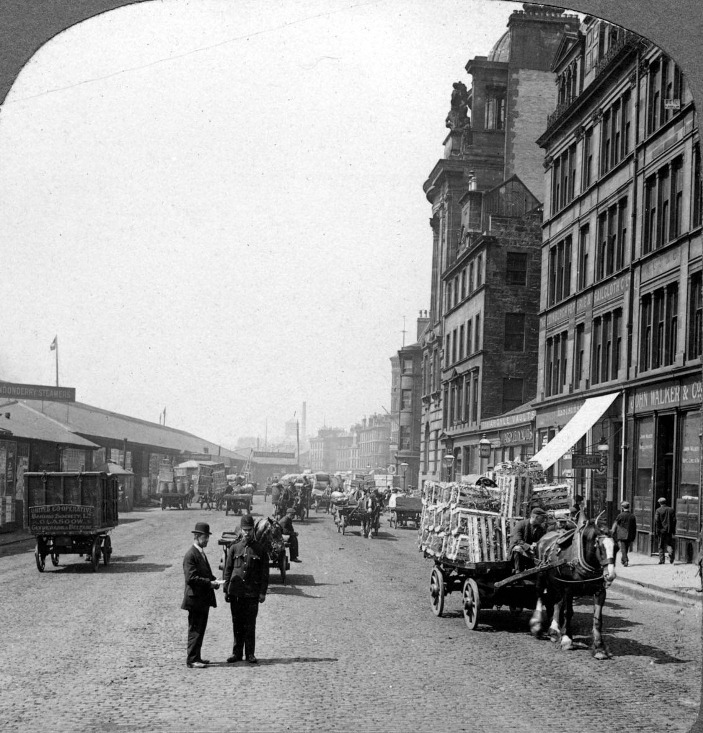
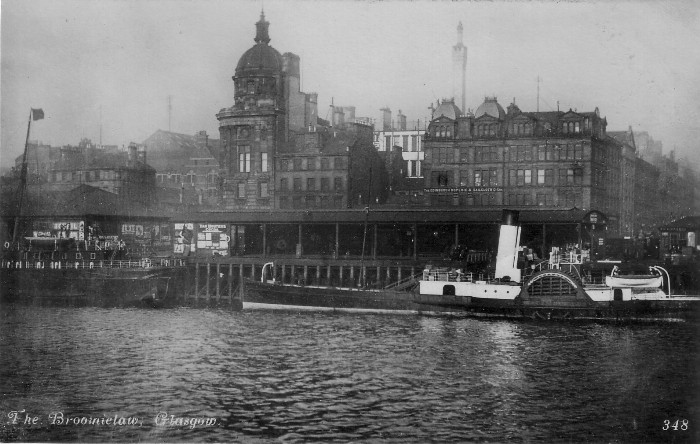
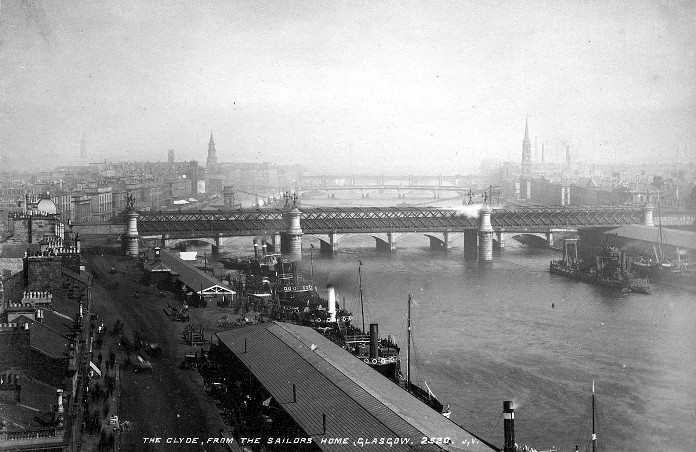
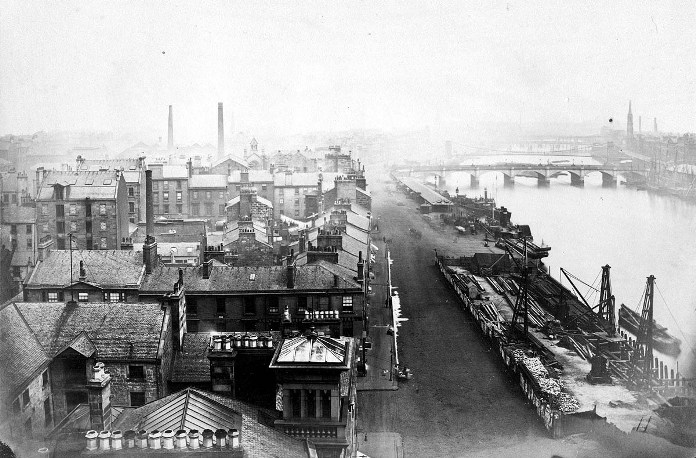
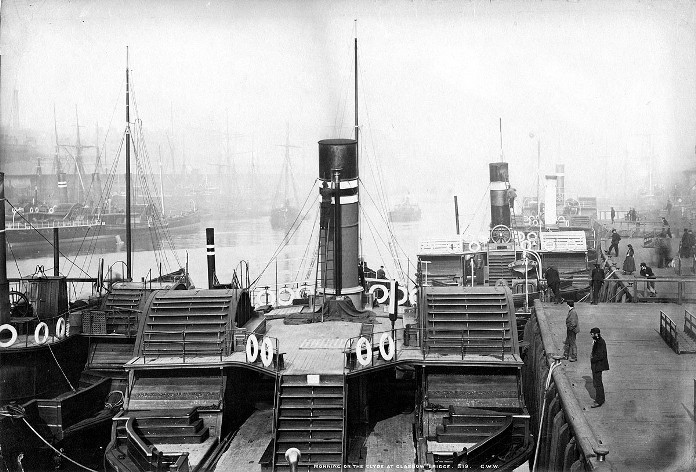
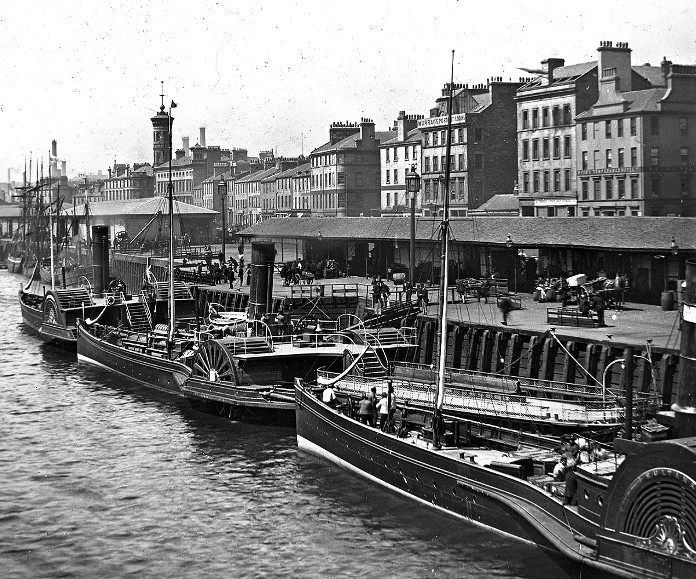
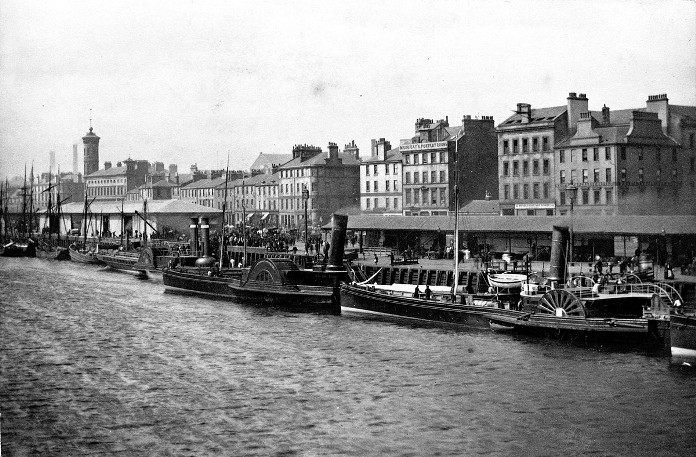
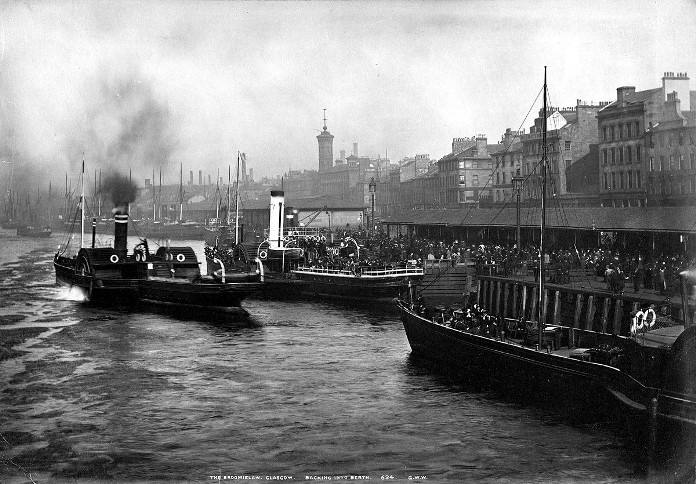
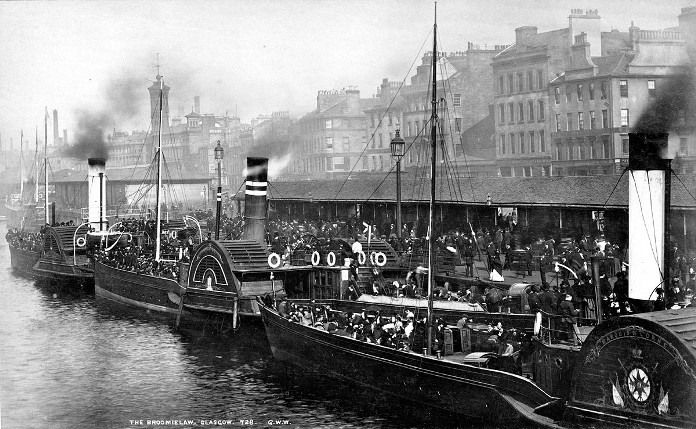
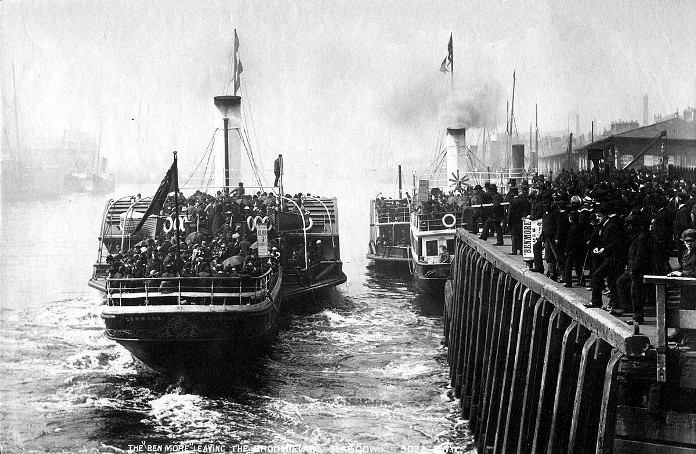
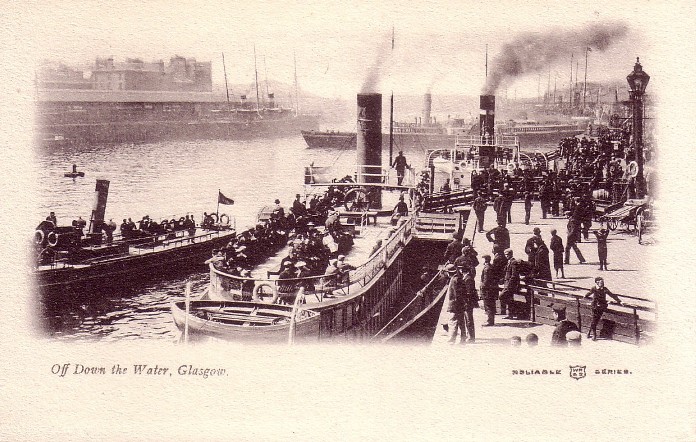
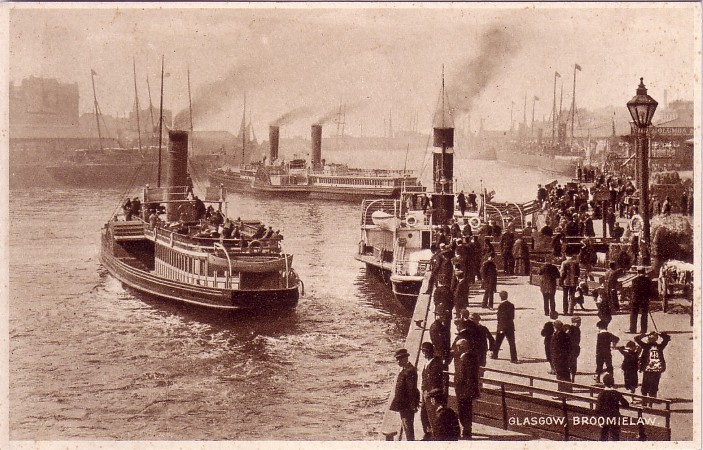
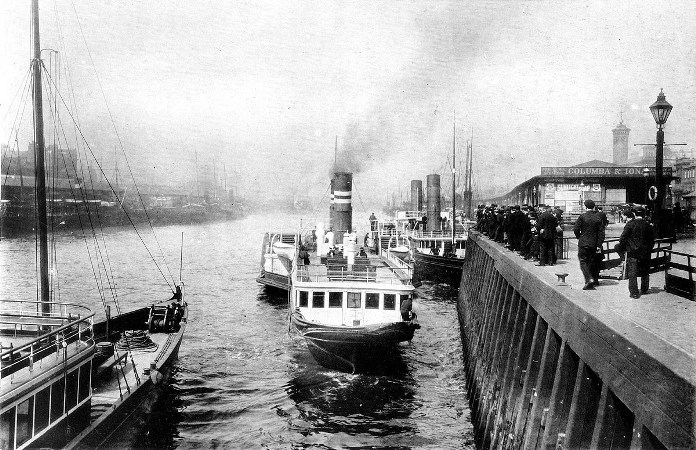
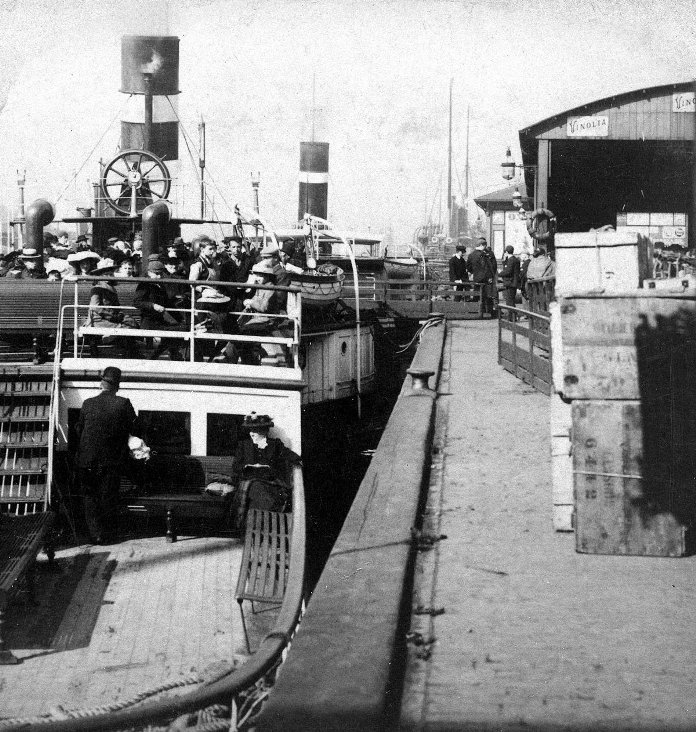
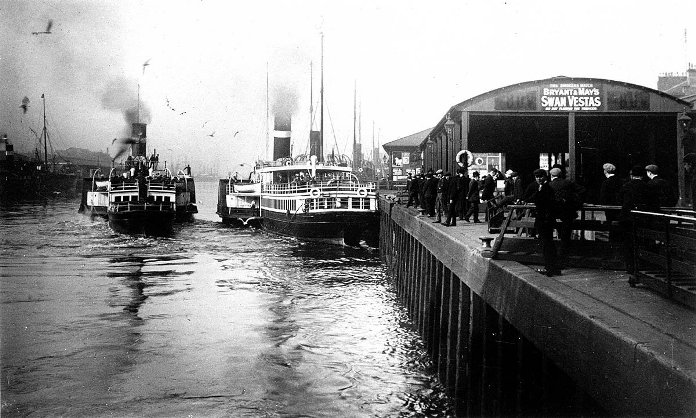
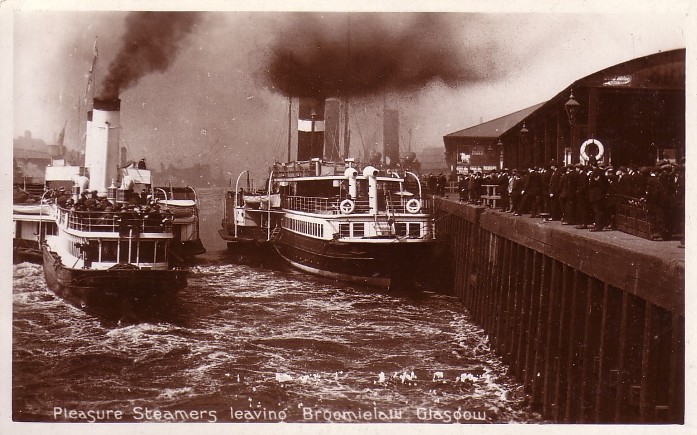

{ 1 trackback }
{ 17 comments… read them below or add one }
← Previous Comments
Hi Chris,
This is great! Thank you so much for this information. In my research I am attempting to develop a narrative to the best of my ability, rather than “connect the boxes” as it were, in a family tree. So much of this story has been lost, especially because the family as immigrants were physically detached from family and homeland so over time it is a challenge to re-build the connections. As I’m sure you and your readers know, looking look back at the challenges faced by our ancestors over 120 years ago is a very sobering but worthwhile experience because we can too easily take for granted all that we enjoy today.
Sincerest best wishes,
Richard
Hi Richard,
Thank you and you are most welcome. What you say is very true and the generations that have gone before us faced great challenges. It is sobering to reflect on these.
With best wishes for your continued success.
Chris
Hi Chris,
Great information and photos that can help put flesh on the bones of a “Reaburn/Ryburn Family in Australia” book I have begun to research in my recent retirement.
My family has Paisley lineage. My 2nd great grandfather, Robert Ryburn (b. Paisley, Scotland 4 Feb 1827; d. 4 Aug 1910 in Melbourne, Victoria, Australia) left his wife Mary (nee McLauchlan b. 20 Apr 1831 in Kilbarchan) and three children in Paisley in 1854-55 to come to Australia and the gold rush in Victoria. His wife and by then only surviving son, Duncan, also left Paisley and travelled on the ship the “Almora” arriving in Melbourne late December 1857.
My research suggest that 1854-55 was a time when a Paisley-based “New Zealand and Australia(n) Emigration Society” headed by James Fergusson was helping Scots emigrate overseas and to NZ and Australia in particular to meet the needs for both skilled labour, females, and farm workers.
My research has found that during their journey from Paisley it was typical to travel by train from the Gilmour Street Station in Paisley, then leave from the Broomielaw in Glasgow on a steamer for Liverpool and then to Australia.
I have exhaustively searched all shipping records to establish exactly when and on what ship Robert left Glasgow/Liverpool, but with no success.
Any insights from any local historians or those interested in helping me solve this mystery would be greatly valued and acknowledged in the book I am preparing.
Cheers from Down Under.
Peter
Hi Peter,
Thank you for your fascinating inquiry. Here is the link to a report on the voyage of the sailing ship “Almora”, departing from Liverpool on 18th November, 1854 and arriving in Port Phillip Bay, Melbourne on 14th February, 1855.
https://www.wikitree.com/wiki/Space:Voyage_of_the_Almora,_Arrived_14_Feb_1855
If your ancestors left Paisley bound for Glasgow by train they would have departed from Gilmour Street Station and traveled eastbound to Bridge Street Station in Glasgow. However, I’m not sure if Liverpool-bound steamers departed from the Broomielaw in Glasgow in the 1850’s. A large rock obstructed the River Clyde at Elderslie, to the west of Glasgow, and this was not cleared until 1886. So navigability was restricted and it seems much more likely, if your ancestors travelled by sea to Liverpool, that they would have taken the train westbound from Paisley Gilmour Street to Greenock Cathcart Station and then walked or used a carter to take them the 300 yards down to the Steamboat Quay. There, they would have boarded one of George and James Burns steamers bound for Liverpool. By 1854, it was also possible to travel to Liverpool by train from Glasgow but with several changes along the way. Let me know if you would like further details on the journey by rail.
Wishing you all the best in your project.
Chris
Hi Chris,
Back again with another question. I put it here because our previous discussion is just above this although this doesn’t directly pertain to it. Specifically, I’m now looking for some info about the Model Lodging House that was on 55-69 Portugal St. in Govan. The census of 1911 includes the name of a young man I strongly suspect became my father’s uncle. I used Google Earth and it looks like the whole building has only been recently torn down. I haven’t been able to locate any photos of it. I understand that there were many Model Lodging Houses. This one was under the authority of the City of Glasgow and seemed to only house men. I would appreciate it if you direct me or supply with with any other info and/or photos of it. On an unrelated topic, I also must thank you for posting that terrific film of Glasgow in 1901. It really does so much to capture the vibrancy and the bustle of the city then. Thanks. Richard
Hi Richard,
Thank you for your message and I’m glad that you enjoyed the 1901 film.
Regarding your inquiry, I do not have much to add. I took a Google tour of the neighborhood and it is in the process of being completed redeveloped. I did not see any tenements and I do not have any early photos of the location.
I checked the Post Office Annual Glasgow Directory for 1911-1912 and came up with the following reference on page 962: 57 Portugal Street, Model Lodging House, supt. J. Rowan. It was located in the block between Dunmore Street and Bedford Lane and flanked by St. John’s R. C. Boys’ School and the Gorbals Foundry, so obviously this block on Portugal Street comprised some large premises. I tried searching for photographs of the school and the foundry but was unable to find any. You might try contacting the Burrell Collection, the Mitchell Library, and possibly also Canmore to see if they have any photos of Portugal Street and these premises in their archive.
https://digital.nls.uk/directories/browse/archive/86498348?mode=transcription
With best wishes,
Chris
Hi Chris,
Very interesting information on the Broomielaw, I wonder if you can provide me with any information on the company W. & J. Aitchison, Carriers Quarters, who were at 186 Broomielaw. This was an office where I vaguely remember going to as a child with my father, who was a lorry driver for Dunabie of Maybole. He was trying to get a return load rather than run back to Maybole empty. Any help would be appreciated.
Best regards,
William
Hi Chris,
Can anyone suggest where I might locate the passenger list for the sailing vessel Carlton, that departed Broomielaw Docks on April 15, 1842, for Quebec?
Maitland
Hi Maitland,
Thank you for your inquiry which I have posted. You may also wish to contact the Mitchell Library in Glasgow. They have an extensive archive of local newspapers, including the Glasgow Courant of 1715. The departure of the Carlton may be listed in a newspaper they possess. I don’t know if a list of passengers would be included.
Glasgow Libraries:
The Mitchell,
North Street,
Glasgow G3 7DN
Phone: 0141 287 2910
Fax: 0141 287 2815
Email: archives@glasgowlife.org.uk
I conducted an online search and discovered the following: “Diary of the Voyage of John Hart of Perth, Ontario: Who Left Glasgow, Scotland, with His Family on the 15th April, 1842, on the Sailing Vessel “Carlton.” Arriving in Quebec, 5th June, 1842, Fifty-one Days.”
Author: John Hart; Publisher: Privately printed for W.A. Newman, 1940: Length: 46 pages
https://books.google.com/books/about/Diary_of_Voyage_of_John_Hart_of_Perth_On.html?id=Vn5MHAAACAAJ
I also searched for arrivals in Quebec and it appears that the Bark “Carlton” was owned by Gilmour & Co. On further checking, the Archives of Rankin, Gilmour & Co. Merchant House are held in the National Museums, Liverpool: Maritime Archives and Library. Perhaps they may include passenger lists.
https://discovery.nationalarchives.gov.uk/details/c/F168596
I hope this helps. With best wishes,
Chris
Hi Chris
I am researching my forebears (Robert and Hellen Wallace and children) who left Melrose for Australia in January 1842, under an assistance scheme by the Rev John Dunmore Lang. I originally believed that travelled by coach to Liverpoll where they boarded the “Formosa”. However, I am now led to believe that went via Glasgow and onward by ship or rail. Would greatly appreciate your thoughts on this.
I am planning to make a video of their migration, and would appreciate information regarding using images from your site.
Many thanks
Richard Balsillie
Melbourne
Hi Richard,
Many thanks for your message and it reminded of previous inquiry in the comments section of the Broomielaw chapter from Peter Reaburn of a family emigrating from Scotland to Australia in the 1850’s. Part of my response to Peter would also apply in the case of your forebears, except that the passenger-carrying railways in the 1840’s were in their infancy in Scotland.
It was such a brave decision of your ancestors to leave Melrose for Australia and if they went via Glasgow they would have travelled there by horse-drawn coach and perhaps stayed overnight in the city before setting off on the next part of their journey. Now, as I mentioned in my response to Peter, I’m not sure if Liverpool-bound vessels departed from the Broomielaw in Glasgow at that time because a large rock obstructed the River Clyde at Elderslie, to the west of Glasgow, and this was not cleared until 1886. So navigability was restricted and it seems much more likely, if your ancestors travelled by sea to Liverpool, that they would have travelled by coach from Glasgow to Greenock, a town on the south bank of the River Clyde. Once there, they would have sought out the Steamboat Quay and boarded a steamer bound for Liverpool. Let me know if you find any further information that would support or contradict this proposed route.
And you are most welcome to use any images from this site in your research.
With best wishes,
Chris
Dear Chris,
Great information…..My memories are of boarding a boat in the fifties going to Dublin. Cattle went below, and passengers were in a lounge area, but there were also cabins. Do you have any information on the boat? It seemed really large to me but then I wasn’t very big at the time.
Thank you.
Eleanor.
Hello Eleanor,
Thank you very much for your inquiry. You would have boarded the boat in question at Anderston Quay on the North Bank of the Clyde. This was where the Glasgow-based Irish boats operated by Burns & Laird and their affiliates would tie up when not in service. If you sailed to Dublin during the Summer of 1953, or later during the 1950’s, you would most probably have been on board the TSMV Irish Coast (III). This was a very substantial, fine-looking vessel with a black hull, white superstructure, and a black funnel with a white V painted on the side. Built for the Coast Lines, this ship was operating under charter with Burns & Laird Lines at the time when you sailed. I hope these details might chime with your recollections.
With best wishes,
Chris
Hi Chris,
These photos are great and you provide such interesting information. Would I be able to use one of the photos with the appropriate credit in an article I am writing for the Scottish Government intranet on the AQ5 building which we now house? It was one of the buildings that was previously the Seaman’s Institute.
Thanks, Suzan
Hello Suzan,
Thank you for your inquiry and you are most welcome to use whatever photos you need. I wish you the best of success with your article.
Chris
Hi Chris,
I’m starting a new adventure with my blog about Robert Louis Stevenson’s Letters and Travels, now concerning his voyage to New York in 1879. He sailed on a commuter ship from the Broomielaw to Greenock. From Greenock he got on the S.S. Devonia to New York. Are there any websites where I can find Glasgow commuter ships connecting the Broomielaw to Greenock on August 6th or 7th, 1879?
Any suggestions you have would be much appreciated! Thank you.
Mafalda
Hi Mafalda,
Thank you for your inquiry and I wish you success in your work on Robert Louis Stevenson’s Letters and Travels. A quick question, are you certain that he sailed from the Broomielaw in 1879? The reason I ask is because a large rock obstructed the river at Elderslie and it was not completely removed until 1886. So before then, people would travel by other means to Greenock and then sail from there.
With best wishes,
Chris